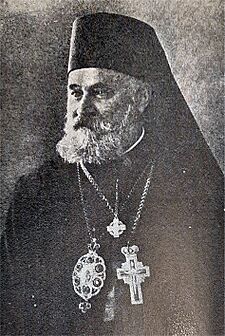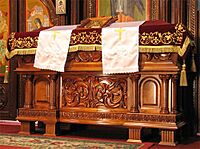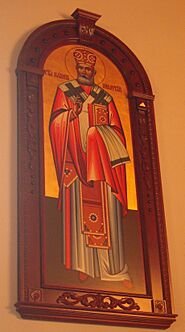Platon of Banja Luka facts for kids
Quick facts for kids Platon of Banja Luka |
|
|---|---|

Bishop Platon (Jovanović)
|
|
| Holy hieromartyr | |
| Born | Milivoje Jovanović 29 September 1874 Belgrade, Principality of Serbia |
| Died | 5 May 1941 (aged 66) Banja Luka, Independent State of Croatia |
| Venerated in | Eastern Orthodox Church |
| Canonized | 21 May 2000, Belgrade, by the Serbian Orthodox Church |
| Feast | 5 May (O.S. 22 April) |
Hieromartyr Platon, Bishop of Banja Luka (born Milivoje Jovanović; 29 September 1874 – 5 May 1941) was a Serbian Orthodox leader. He served as the Bishop of Banja Luka from 1940 to 1941. His time as bishop ended in May 1941 when he was captured and killed by followers of the Ustaše movement.
Platon studied at a seminary in his hometown of Belgrade. He later graduated from the Moscow Theological Academy. He worked as a military chaplain (a priest serving in the army) during the Balkan Wars (1912–1913) and at the start of World War I. In 1936, he became a bishop. In October 1940, he became the Bishop of Banja Luka.
Six months later, Yugoslavia was invaded by the Axis powers. Banja Luka became part of the Independent State of Croatia (NDH). This was a fascist "puppet state" (a country controlled by another power) led by the Ustaše. On April 24, the Ustaše leader in Banja Luka, Viktor Gutić, ordered everyone born in Serbia or Montenegro to leave the city. Platon refused to obey.
On the night of May 4–5, he was arrested by the Ustaše. The next night, he and another priest were taken from their cell. They were driven outside Banja Luka and killed. Platon's body was found on May 23 and buried the next day. He was one of many Serbian Orthodox priests killed during the war. In 1973, his remains were moved to the Church of the Holy Trinity in Banja Luka. In 1998, the Serbian Orthodox Church recognized him as a hieromartyr (a saint who died for their faith). He was officially made a saint (canonized) two years later. His special day, called a feast day, is celebrated every year on May 5.
Contents
Bishop Platon's Life Story
Early Years and Education
Platon was born Milivoje Jovanović in Belgrade, Serbia, on September 29, 1874. His father, Ilija, was a soldier. His mother, Jelka, was from Foča. He was baptized at the Church of the Ascension in Belgrade.
He finished his early schooling in Vranje and Niš. In 1892, Jovanović joined the Serbian Orthodox seminary in Belgrade. Three years later, in 1895, he became a monk and took the name Platon. He finished seminary in 1896. He then became a deacon and later a presbyter (priest).
In 1896, Platon moved to Russia to continue his studies. He joined the Moscow Theological Academy in 1897. He was the first Serb to receive the Ivan Aksakov Scholarship.
Platon finished his studies in Moscow in 1901. When he returned, he was given the rank of syncellus. He was assigned to the Rajinovac Monastery near Belgrade. Platon wanted to teach at the seminary, but his request was denied. Instead, he taught theology at a school in Aleksinac from 1903 to 1906. He also taught in Jagodina for a few months in 1906. In 1906, Platon became a certified professor of theology. He was also promoted to the rank of protosyncellus. In 1908, he became the editor of the Gazette of the Serbian Orthodox Patriarchate. The next year, he was promoted to archimandrite. In 1910, he stopped being the editor of the Gazette.
Serving as a Priest
When the Balkan Wars started in November 1912, Platon became a military chaplain for the Royal Serbian Army. He also served as a military chaplain at the beginning of World War I. He stopped being a chaplain on December 11, 1914. He was allowed to go back to teaching at the seminary.
He stayed in Serbia during the entire war. He refused to leave for the Greek island of Corfu with the army after Serbia was defeated. By late 1918, the war ended. The Kingdom of Serbs, Croats and Slovenes (later called Yugoslavia) was formed. In 1919, Platon was forced to retire from the church. He had to work as an apprentice in a carpentry shop.
After a few months, Platon found work as an accountant. He later became the manager of a publishing house. In 1922, after one of his main rivals died, Platon was allowed to return to being a priest. He became the archimandrite of the Rakovica Monastery. He also managed its monastic school.
Later, Platon was accused of misusing money and was removed from his duties. He tried to appeal this decision many times but was not successful. He then asked the Minister of Education to let him teach at a seminary, but this was also denied. He then appealed to Dositej, the Bishop of Niš. Dositej promised Platon a teaching job at a local seminary. However, Platon's opponents in the Ministry of Education made sure his request was ignored. Dositej then appointed Platon as the archimandrite of the Poganovo Monastery.
In 1930, Patriarch Dimitrije died. This led to some of Platon's political opponents losing their positions. In 1932, the church leaders cleared Platon of the past charges from his time at Rakovica. In November 1932, Platon became the manager of the monastery printing press. He also became the editor of the Gazette of the Serbian Orthodox Patriarchate again. In 1933, he started a children's newspaper called Little Bogoljub. The next year, he became the archimandrite of the Krušedol Monastery.
Becoming a Bishop
On October 4, 1936, Platon became a bishop. The ceremony was led by Patriarch Varnava. It took place in Sremski Karlovci. During a time of political tension, Platon wrote a pamphlet (a small book) called "Remarks and Objections to the Concordat Project." This document was published without his name on it. But it soon became known that Platon was the author. This caused problems between him and the government, led by Prime Minister Milan Stojadinović.
On July 19, 1937, a vote on the concordat (an agreement with the Catholic Church) was held in the National Assembly. This led to street protests by Serbian Orthodox leaders. The police used force to stop the protests. Platon was involved in the clashes. A bishop and a priest were killed. The newspapers called these events the Bloody Liturgy. On July 23, the National Assembly approved the law. However, Stojadinović said he would delay putting the agreement into action to improve relations with the Serbian Orthodox Church. A few hours later, Patriarch Varnava died.
On June 22, 1938, the church leaders chose Platon to become the Bishop of Ohrid and Bitola. When he arrived in Macedonia, Platon found that the priests in his area were arguing. On December 19, 1939, during a service for Saint Nicholas, Platon gave a sermon. He criticized his predecessor (the bishop before him) for causing arguments. These comments were controversial. The church leaders sided with the previous bishop. They demanded that Platon apologize. Platon had to apologize to avoid being removed from his position.
The Ministry of Religious Affairs wanted him to retire. However, the church leaders decided to move Platon to the Eparchy of Banja Luka. Because his opponents said they would protest his arrival, Platon arrived in Banja Luka without announcing it. On October 1, 1940, he became the Bishop of Banja Luka without a formal ceremony. To prevent this from happening again, the church leaders soon made a rule against bishops taking their posts without a formal ceremony. But Platon was allowed to keep his position.
His Final Days
After the Axis powers invaded Yugoslavia in April 1941, Bosnia and Herzegovina became part of the Independent State of Croatia (NDH). This was a "puppet state" controlled by the fascist Croatian nationalist Ustaše movement. Their leader was Ante Pavelić. The Ustaše quickly started making laws against Serbs, Jews, and Roma. Their main targets were Serbs. The Ustaše blamed Serbs for many problems in Yugoslavia before the war.
Soon after the NDH was formed, Viktor Gutić became the Ustaše leader for Banja Luka. Gutić quickly put in place many anti-Serb and anti-Semitic (anti-Jewish) rules. All Serbs, Jews, and "enemies of the state" working for the government lost their jobs. These jobs were given to Croats and Bosnian Muslims who supported the Ustaše. Also, Serbs and Jews were not allowed to use the same public transport as Croats and Bosnian Muslims. On April 24, Gutić ordered that everyone born in "the former Serbia and Montenegro" must leave Banja Luka within five days.
Platon decided to meet with Gutić. He wanted to try and ease the anti-Serb rules. He also hoped to convince Gutić to delay the deportation deadline. Platon chose Dušan Mačkić, a priest, to be his messenger. Mačkić and Gutić met on April 27. During the meeting, Gutić called the anti-Serb rules "God's punishment for you Serbs." But he agreed to delay the deportations by ten days.
After their talk, Gutić surprisingly decided to name Mačkić as Platon's successor. This was because Platon was scheduled to be deported. Mačkić said he was not next in line after Platon. But Gutić insisted, saying Platon's deputy bishop, Sava, was born in Montenegro and would also be deported. Mačkić reluctantly accepted the role. This decision made many local priests unhappy. A few days later, local newspapers reported that Mačkić had been appointed Platon's successor. People started coming to Mačkić's home, asking him to help their friends and family.
Even though he was born in Serbia, Platon refused to leave his diocese (church area). On May 1, he wrote a letter to Gutić. He promised he would not "abandon his flock" (his church members), no matter what Gutić's order said. He was arrested by the Ustaše on the night of May 4–5. Many other important Serbs and Serbian Orthodox priests were also arrested that night.
Platon was held in a prison known as the Black House. Dušan, a priest from Gradiška, was his cellmate. On the evening of May 5, Platon and Dušan were taken from their cell by Asim Đelić, one of Gutić's bodyguards. With two other Ustaše, Mirko Kovačević and Nino Čondrić, Đelić forced the two priests into a car. They drove them out of the city. They were then taken to the banks of the Vrbas river, near the village of Rebrovac, and killed.
Bishop Platon's Legacy
Through a messenger, Mačkić convinced some Bosnian Muslim and Croat civilians to bury Platon's body. On May 24, his body was buried without a ceremony at a military cemetery in Banja Luka. The cross above his grave had no name on it.
Out of ten Serbian Orthodox bishops in the NDH, three were killed, including Platon. The nine Serbian Orthodox church areas in the NDH were destroyed. The Serbian Orthodox Church "practically ceased to exist" in that state. In April 1941, there were 577 Serbian Orthodox priests, monks, and other religious leaders in the NDH. By December, there were none left. Historians say that between 214 and 217 were murdered. Many others were sent away to German-occupied Serbia.
In October 1944, Đelić was executed by the Croatian Home Guard general Vladimir Metikoš. A later investigation found that Gutić had ordered Platon's killing. As the NDH fell apart in 1945, Gutić fled to Italy. He was later caught and sent back to Yugoslavia. He was put on trial for his wrongdoings during the war. He was found guilty in February 1947 and executed later that month.
On July 1, 1973, Platon's remains were dug up. They were reburied in the crypt (an underground room) of the Church of the Holy Trinity in Banja Luka. This church had been destroyed by the Ustaše during the war and had only recently been rebuilt.
In 1998, the Serbian Orthodox Church recognized Platon as a hieromartyr. This means he was a saint who died for his faith. The religious scholar Dimitri Brady believes Platon was killed for his ethnic background as much as for his religious beliefs. Platon was officially made a saint by the Serbian Orthodox Church on May 21, 2000. The ceremony was held in Belgrade's Cathedral of Saint Sava. Several other priests who died at the hands of the Ustaše were also made saints at this time.
Platon's remains were then moved from the crypt. They were placed as relics (holy objects) inside a sarcophagus (a stone coffin) in front of the church's altar. Platon's feast day is celebrated every year on May 5, the anniversary of his death.
See also
- List of Serbian saints



